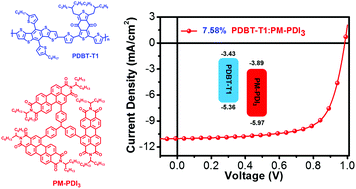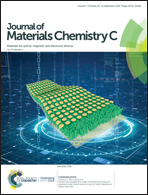Methane-perylene diimide-based small molecule acceptors for high efficiency non-fullerene organic solar cells†
Abstract
We report perylene diimide (PDI) small molecules based on diphenylmethane, triphenylmethane, and tetraphenylmethane cores, named PM-PDI2, PM-PDI3 and PM-PDI4, respectively. The OSC performances of PM-PDI3 and PM-PDI4 are comparable. The PM-PDI3 based device with PDBT-T1 as the donor achieved a highest power conversion efficiency (PCE) of 7.58% along with a high open-circuit voltage (VOC) of 0.98 V, a short-circuit current density (JSC) of 11.02 mA cm−2 and a high fill factor (FF) of 69.9%, a 1.32 times boost in PCE with respect to the PM-PDI2 based control device (3.26%). The high photovoltaic performance of the PM-PDI3 based device can be attributed to its relatively high-lying LUMO level, complementary absorption spectra with the polymer donor material PDBT-T1, relatively favorable morphology and improved exciton dissociation and charge collection efficiency. A PCE of 7.58% is among the highest efficiency of phenyl-methane as core based non-fullerene organic solar cells. Overall, this work provides a new approach to enhance the performance of non-fullerene acceptors.



 Please wait while we load your content...
Please wait while we load your content...